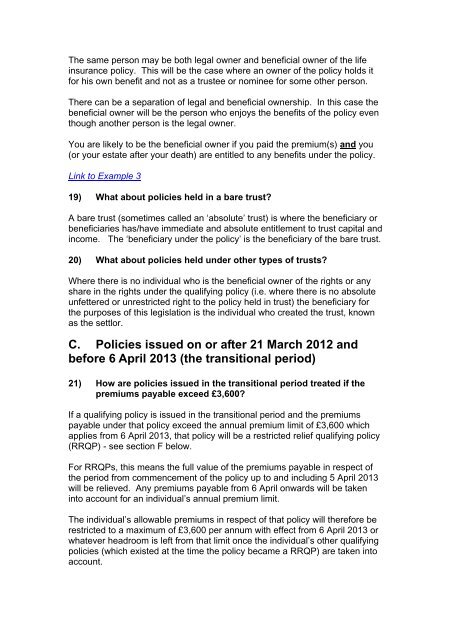FAQ's – Life Insurance – Qualifying Policies - HM Revenue & Customs
FAQ's – Life Insurance – Qualifying Policies - HM Revenue & Customs
FAQ's – Life Insurance – Qualifying Policies - HM Revenue & Customs
You also want an ePaper? Increase the reach of your titles
YUMPU automatically turns print PDFs into web optimized ePapers that Google loves.
The same person may be both legal owner and beneficial owner of the life<br />
insurance policy. This will be the case where an owner of the policy holds it<br />
for his own benefit and not as a trustee or nominee for some other person.<br />
There can be a separation of legal and beneficial ownership. In this case the<br />
beneficial owner will be the person who enjoys the benefits of the policy even<br />
though another person is the legal owner.<br />
You are likely to be the beneficial owner if you paid the premium(s) and you<br />
(or your estate after your death) are entitled to any benefits under the policy.<br />
Link to Example 3<br />
19) What about policies held in a bare trust?<br />
A bare trust (sometimes called an ‘absolute’ trust) is where the beneficiary or<br />
beneficiaries has/have immediate and absolute entitlement to trust capital and<br />
income. The ‘beneficiary under the policy’ is the beneficiary of the bare trust.<br />
20) What about policies held under other types of trusts?<br />
Where there is no individual who is the beneficial owner of the rights or any<br />
share in the rights under the qualifying policy (i.e. where there is no absolute<br />
unfettered or unrestricted right to the policy held in trust) the beneficiary for<br />
the purposes of this legislation is the individual who created the trust, known<br />
as the settlor.<br />
C. <strong>Policies</strong> issued on or after 21 March 2012 and<br />
before 6 April 2013 (the transitional period)<br />
21) How are policies issued in the transitional period treated if the<br />
premiums payable exceed £3,600?<br />
If a qualifying policy is issued in the transitional period and the premiums<br />
payable under that policy exceed the annual premium limit of £3,600 which<br />
applies from 6 April 2013, that policy will be a restricted relief qualifying policy<br />
(RRQP) - see section F below.<br />
For RRQPs, this means the full value of the premiums payable in respect of<br />
the period from commencement of the policy up to and including 5 April 2013<br />
will be relieved. Any premiums payable from 6 April onwards will be taken<br />
into account for an individual’s annual premium limit.<br />
The individual’s allowable premiums in respect of that policy will therefore be<br />
restricted to a maximum of £3,600 per annum with effect from 6 April 2013 or<br />
whatever headroom is left from that limit once the individual’s other qualifying<br />
policies (which existed at the time the policy became a RRQP) are taken into<br />
account.

















